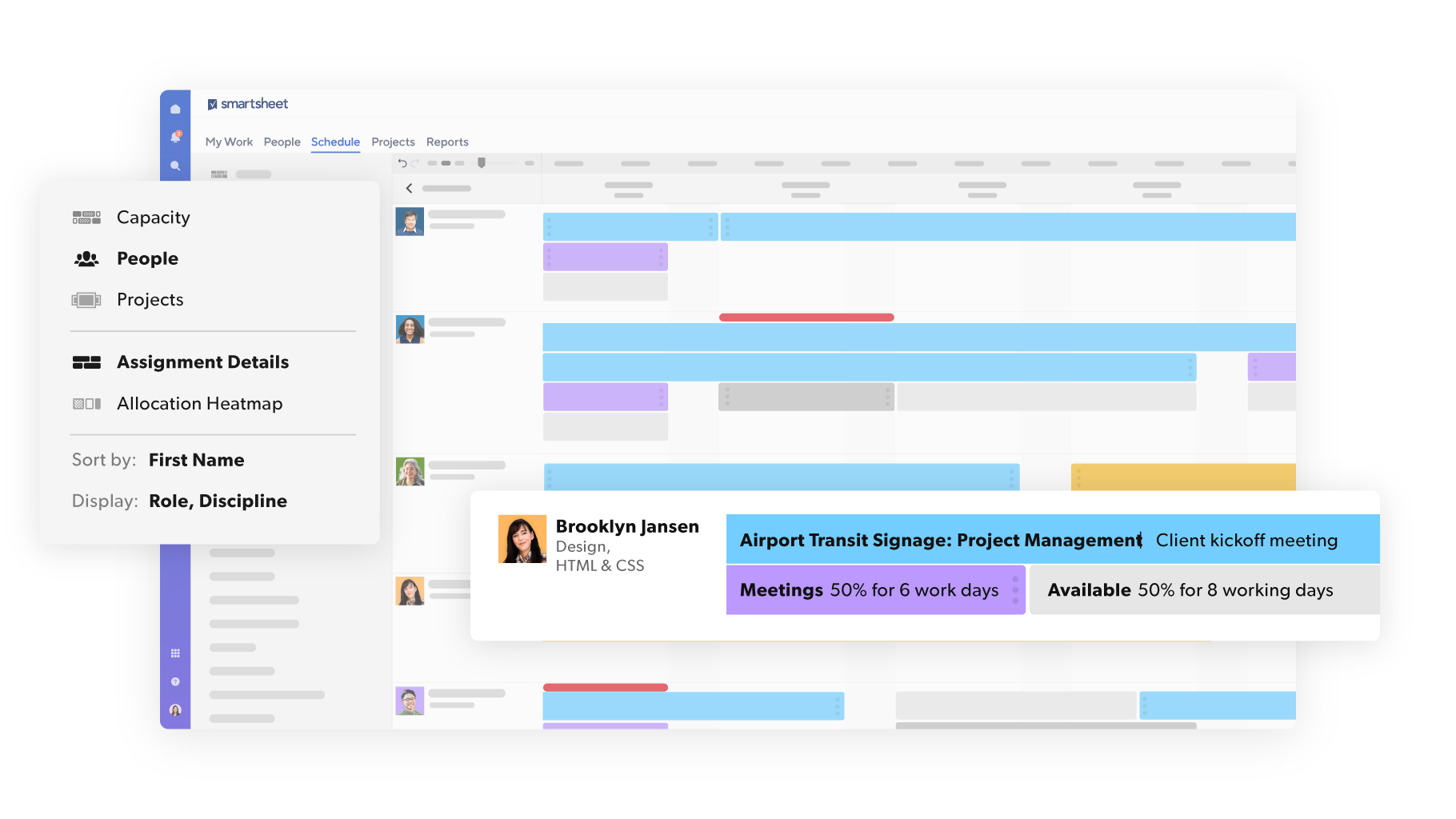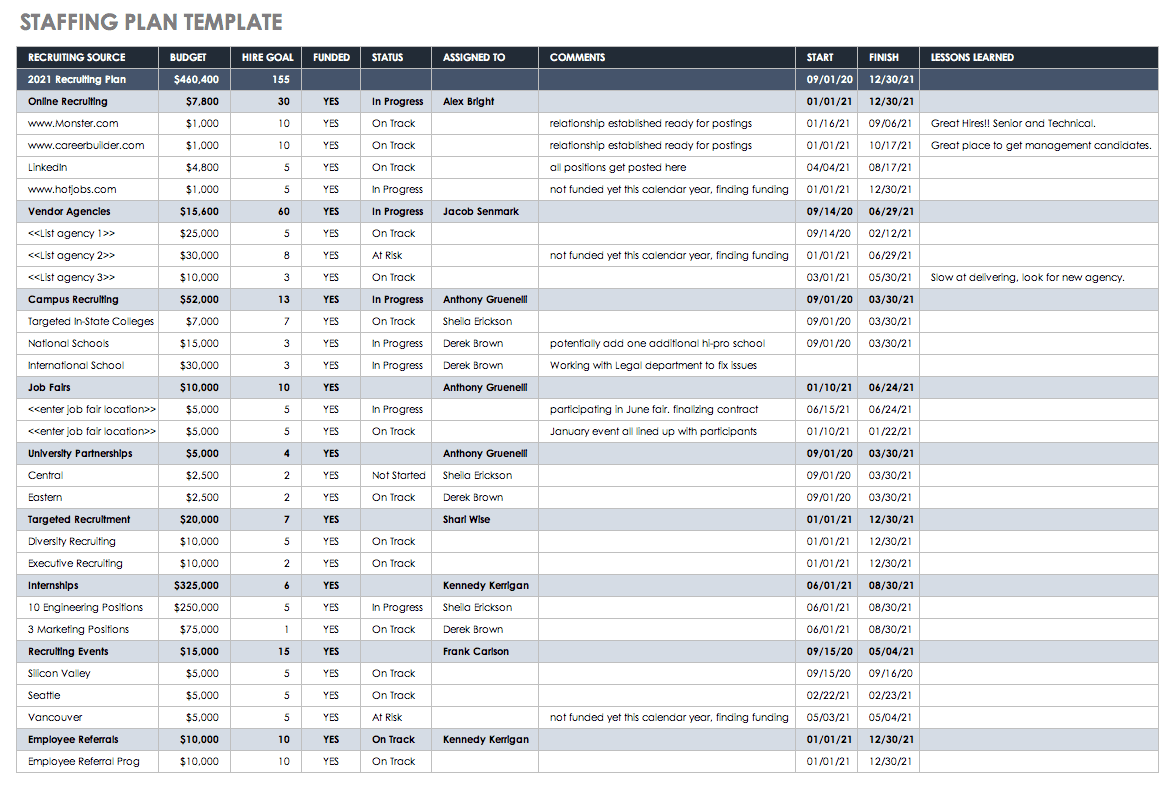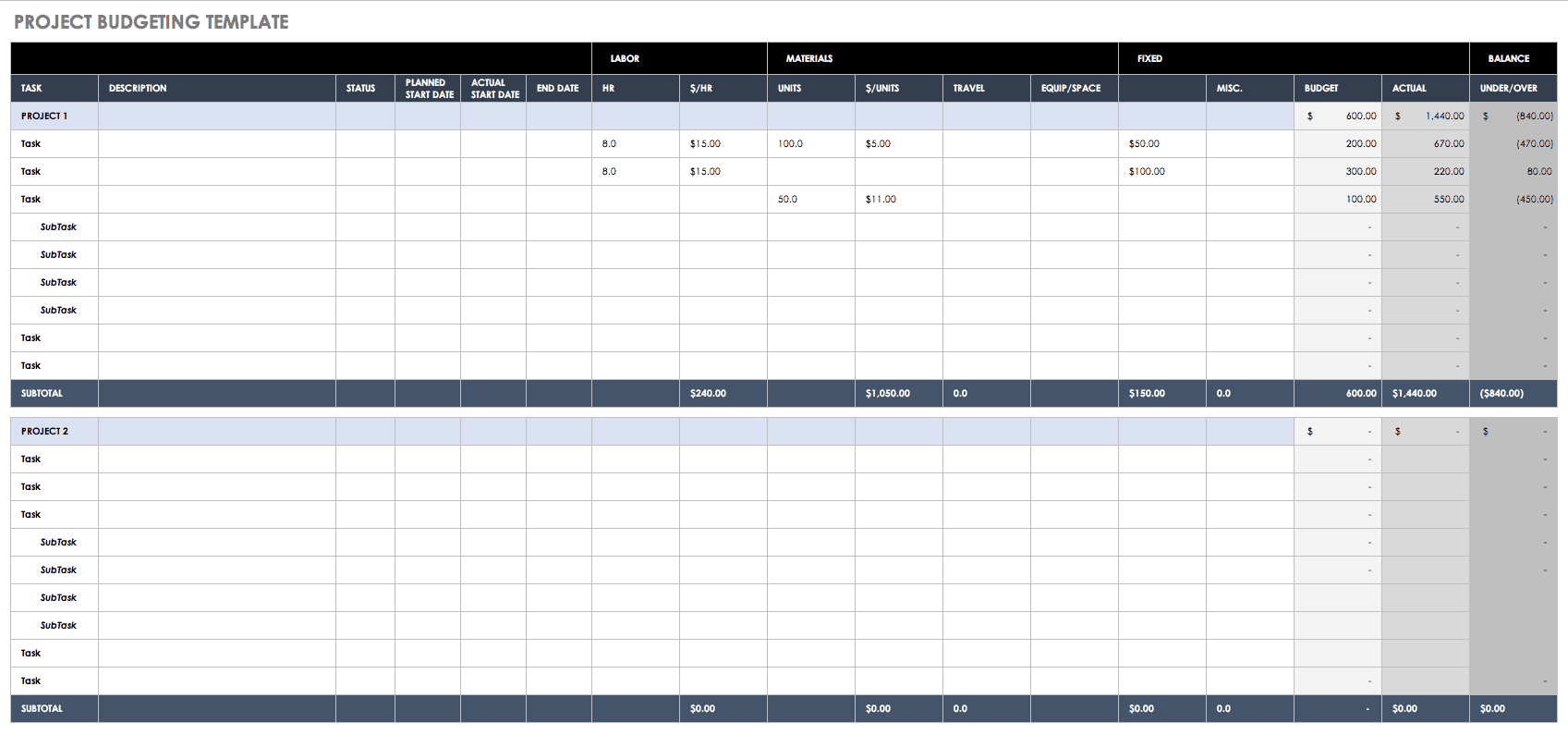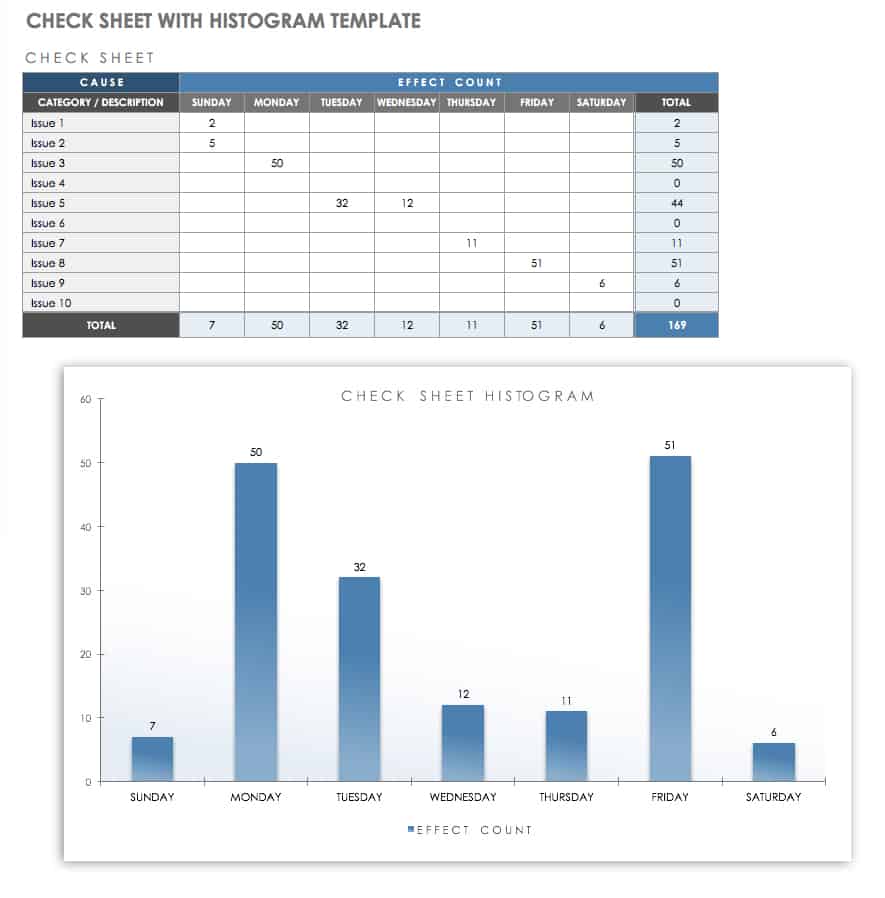What Is Resource Management?
A component of project management, resource management is a process designed to use human and tangible assets — finances, materials, and equipment — efficiently, effectively, and economically. Because the goal of resource management is to utilize 100% of resources, it is one of the most difficult processes to control, maintain, and achieve success.
Resource management is the art and science of organizing finite resources, including human resources, to get your project to the finish line. You can use Word documents, Excel spreadsheets, or project management software (either individually or in combination) to handle what can be a chaotic process. Whatever tools you use, you need to stay on top of resources, from day one to the planned completion date, to ensure that you successfully meet budgets and timelines.
Build the right team for every project

Resource Management by Smartsheet helps you align skills, availability, and capacity to deliver better results—without burnout. Get a clear view of who’s available, what they’re working on, and how to staff projects with confidence.
Why Is Resource Management Important?
Resource management is all about ‘working back’ from a final project objective and creating a plan that maximises, as closely as possible, any and all resources, both human and non-human. “As Stephen Covey famously said, ‘start with the end in mind,’” says Zucker.
Types of Resource Management and Managers
Industries that commonly use resource management include large-scale manufacturing, construction, high-tech, software, advertising, marketing, research, and consulting/professional services. In smaller companies, team members may double or triple up on duties to handle the workload, while in larger firms managers may be in charge of coordinating specific areas of responsibility.
The following list includes different types of resource managements and some templates to help get you started:
- Resource Management: Resource managers chart the course that guides resources to the right places, sometimes months or years in advance. Resource managers usually work in collaboration with a PMO (project management office) and its project managers to scrutinize costs, resource availability, and deadlines as they navigate the optimal deployment of people to projects. In many organizations, project managers also act as resource managers. To learn more about resource management on a large scale, read “Transform Your Business with Enterprise Resource Planning.”
- Project Management: Project managers control tasks and teams to achieve predetermined goals in clearly defined sequences and time frames. When an organization has a PMO, it sets up and maintains standards for project managers to follow. Often, PMO standards are aligned with best practices guidelines in the Project Management Body of Knowledge (PMBOK) from the Project Management Institute (PMI). For free tools and tips, check out these project management resources and marketing solutions.
- Human Resources Management: People are the main resource of any company, and finding and managing team members that ‘fit’ is of strategic and tactical importance. Human resources management deals with recruiting and selecting the right people, providing appropriate onboarding, and developing performance appraisals and compensation and benefits. Human resources management is also concerned with staff motivation, safety and welfare, and complying with labor regulations. Human resource managers and teams are evolving beyond a traditional, task-oriented position to a more strategic organizational role. To learn more, read “Human Resource Management 101: Functions, Policies & Procedures” and “Welcome to the HR Revolution: Strategic Human Resources Management.”
- Natural Resource Management: This is the stewardship of resources like land and soil, water, and plants and trees, so they’ll be available for future generations.
- Financial Resource Management: This pertains to anything related to money, including assets (cash, stock, bonds, etc.) and debts (like loans).
- Enterprise Asset Management: This refers to directing the capital assets of an enterprise, like a corporation or non-profit.
- Public Asset Management: Directing the capital asset of a government, like city, county, state, or a nation.
- Digital Asset Management: Maintaining the storage and security of digital items (e.g. corporate documents, media).
- Facility Management: This is related to the operation of buildings like offices, data centers, warehouses, and hospitals.
- Infrastructure Management: Building, operation, and maintenance of structures like roads, bridges, electrical grids, and sewers.
- Inventory Management: Maintaining the inventory of a business to maximize profitability and customer satisfaction.
- IT Service Management: Overseeing the information technology assets and services for an organization, often by a third party via an SLA-based contract.
Comprehensive Resource Management Best Practices
Resource management is an ongoing process that requires constant monitoring and adjustment based on resource availability, the demands of varying projects, and changes in priorities. Following the practices below can make resource management a more effective tool:
- Create a centralized resources pool to aid allocation of resources among projects and support a common approach to prioritizing projects and work.
- Track resource allocation and availability throughout the life of each project to maximize resource usage and prevent delays.
- Track not just human resources, but also financial, inventory, and material resources.
- Keep each human resource's skills and strengths up to date as skill sets change, to ensure these resources are used effectively and to help with resource leveling.
- Don’t over-allocate resources, as this will limit multi-tasking and burnout.
- Plan around the availability of constrained resources in order to prevent them from being overcommitted.
- Prioritize tasks and projects, and then strategically allocate resources to support KPIs and align with business needs.
- Determine which resources will be in short supply in the future and plan to increase them.
- Support different work styles across the organization to increase efficiency.
- Ensure non-project time is tracked to prevent over-allocation of resources and delays in work.
- Keep the most valuable assets happy and productive.
- Never forget that human resources are people that require a sense of stability and security, fair compensation based on their performance, and opportunity for advancement.
In a research article titled “Relationship Between Human Resource Management Practices, Enterprise Strategy and Company Outcomes: Service Industry of China,” authors Nausheen Syed, Lin Xiaoyan, Syed Kamran Ajmal, and Khan Mansoor Shaukat posit the following hypotheses:
- Human resource management practices are closely linked with performance of service companies.
- There is a close association between HRM practices and business strategies of service companies.
- Strategic orientation is related to higher company performance.
- Incorporating HRM practices with enterprise strategy will be significantly and positively linked with company performance of service firms.
Using data gathered while studying companies in China, the researchers were then able to show that the use of practices like strategic allocation of resources, keeping valuable assets happy, and providing opportunities for advancement lead to increased organizational performance.
Key Facets of Human Resource Management
In their book Assessment Centers in Human Resource Management, George C. Thornton III and Deborah E. Rupp lay out the high-level functions of a strong human resource management program. While the main focus of the book is using assessment centers in the process, these categories apply to HR management in general.
- Recruitment: Seek out people that might fill open positions (both current and future).
- Selection: Choose the most qualified candidates from those recruited.
- Placement: Match each hired candidate to the position best suited to their skills and abilities.
- Training and Development: Give people the tools, skills, and training they need to succeed and advance.
- Performance Appraisal: Evaluate the accomplishments and competence of people, and make a plan to improve those that are lacking.
- Organizational Development: Make changes to the organizational structure to improve efficiency and productivity.
- Human Resource Planning: Ensure that there will be enough people available in the future.
- Promotion and Transfer: Move people to new positions as their skills and the needs of the organization changes.
- Layoffs: The process of reducing headcount is not pleasant, but it needs to be accounted for when outside forces or changes in priorities result in too many employees or employees whose skills no longer meet the needs of the organization.
Resource Management Templates
The templates below help create a structure to track resource deployment. You’ll be able to see resource availability and allocation, track instances of overallocation.
Staffing or Recruiting Plan
Finding the right people to join your team is one of the most important components of resource management and organizational success. A staffing plan ensures that you have the right people at the right time. This template is an at-a-glance resource to make organizing your staff more manageable with goals, budgets, and status and comment columns. This template can also be customized and updated based on your staffing needs.
Financial Resources Management
Finances are planned, organized, controlled, and monitored to achieve organizational targets. For funds to be used most effectively, teams set and agree upon objectives, develop and evaluate policies, and put strategies, tactics and actions in place. Financial managers are responsible for the financial health of an organization and consult with the C-Suite in decision making. For more information on financial resources management, take a look at “Free Financial Planning Templates” and “Free Business Budget Templates for Any Company.”
Project Budget Template
This practical template makes it easier to manage costs by project and tasks. Depending on the type of project, you may include equipment costs, contract employees, supplies, and other job-specific expenses. Tracking actual costs against estimates is also useful in modeling budgets for future projects.
Download Project Budget Template
Distribution Management or Distribution Management Planning
Distribution management is a systematic process to make the delivery of goods more efficient by determining which items, in what amounts, and at what location, are needed to meet forecasted demand. The aim is to reduce ordering, transporting, and holding inventory to reduce costs and minimize shortages. The distribution manager forecasts inventory depletion and plans replenishment so no shortages occur. In this role, the distribution manager has to be conversant with complex telecommunications and IT systems, and often acts as a liaison with manufacturers, suppliers, retailers, and consumers.
Inventory Management Template
Inventory management is the supervision of stock items and non-capitalized assets. Inventory managers supervise the movement of goods from manufacturers to warehouses and then to the point of sale. Detailed daily records are kept for both new and returned items. Inventory management can be complex, no matter the size of an organization, but there should always be set processes in place to follow. Inventory managers lead inventory or warehouse teams, hire staff, write schedules, and monitor stock levels so they know when to replenish supplies. They are also time focused and aim for perfection: zero shortages. Learn more and download templates at “Inventory Management 101: From Simple Inventory to Cloud-Based Management.”
This template enables inventory level monitoring, order requests, and re-order history in a single view. Set alerts for low stock quantities, check status on your mobile device, and track resupply orders.
Download Inventory Management Template
Space Management
Space management refers to managing physical space for maximum efficiency. It seems simple, but it’s complicated in practice. In manufacturing and warehouse environments (think of Amazon’s gigantic operations in multiple locations), space planning can be a major undertaking. It’s also an important part of retail environments to improve margins, make displays more appealing to customers, and increase overall sales. Typically, space managers have interior design, architectural, or engineering experience.
Information Technology Management
Information technology (IT) management aligns business strategies with company technology. To generate the most value, IT managers strive for a silo-free technology environment. IT managers create synergistic, creative collaboration between IT functions and infrastructure environments and converge facilities, management, security, servers, networking, and storage. Integrating and automating IT means companies of every size can get applications in operation sooner. Like any resource management process, one of the benefits IT management brings is the ability to adjust resources more quickly to meet unpredictable business demands.
Utilization Management
“Utilization management is highly specialized — it’s about patient care and health insurance usage,” says Zucker. Also known as utilization review, utilization management evaluates the suitability and medical requirement of health care procedures, services, and facilities using evidence-based criteria under the provisions of an applicable health insurance plan. Utilization management helps minimize costs and determine if the recommended treatment is appropriate. Typically, utilization managers work collaboratively in a medical setting with a variety of administrative personnel and clinicians.
Techniques and Principles of Effective Resource Management
“We monitor team utilization and billability as well as staffing skills, which all informs capacity,” says Hunter. “Our teams are primarily project based, so the tools we use are important in managing our day-to-day utilization and load balancing, and to keep on track. “We use data to determine utilization rates. Project management partners closely track data with finance reporting to ensure our forecasted revenue and utilization is on target.”
Managing resources effectively requires bringing together many different tools, techniques, principles, and disciplines, which are discussed below.
- Resource Planning: Begin by creating a detailed list of every resource, human and non-human, you need to complete the project. Involve team members in the process, since some aspects of the project may require resources you don’t know about. It’s better to plan for every possible item and not use them than to underestimate your needs, and end up scrambling and paying a premium at the last minute. In many ways, resource planning is financial planning.
- Estimating and Forecasting: Perfection is nearly impossible to achieve in resource management, but you should still aim for it. Once project priorities have been clarified, take adequate time to estimate schedules and budget. Look to completed projects, including what went wrong, to help develop reasonable estimates and forecasts. Additionally, while you need to listen to management, estimates and forecasting should be realistic, and not simply fit management targets or unreasonable time frames. Update estimates periodically to reflect changes such as new decisions, shifts in resources, and the impact of these changes on the project as they happen.
Keeping an eye on all the moving parts of a project ensures that you maintain control of time, tasks, risk, and changes. Visually representing data in one place facilitates transparency and communication with team members, and holds the line on schedules and approved budgets.
Download Project Management Dashboard Template - Excel
- Resource Breakdown and Prioritization: Use your original resource planning list to assess each item and give it a priority ranking. It’s up to you to identify hierarchies relevant to your project and business. This prioritization process compares the relative urgency and importance of requirements to cope with finite project resources. Careful prioritization ensures that the most critical requirements are immediately addressed if time or budgets change.
- Responsibility Assignment Matrix: Once you prioritize the needed resources, define the people who are responsible for task or overall project completion with a responsibility assignment matrix (RAM). Use the matrix to clarify roles and responsibilities for the full scope of the project. RAMs are often simple RACI charts (responsible, accountable, consulted,” and informed). Charts can be created by naming the individual or role. Learn more in “A Comprehensive Project Management Guide for Everything RACI.”
- Resource Overallocation: Overallocation means that a team member can’t finish the assignment in the scheduled time frame. This can lead to overtime costs, or in the worst case scenario, can derail the project. Resource balance is critical, so monitor your team’s workload throughout the project’s lifecycle, and check workloads on a regular if not daily basis.
A resource histogram is a visual representation of the project team. Seeing status in this format helps prevent overallocation. If you see an area of concern, take action and shift tasks to a team member with a lighter workload. This template combines a weekly check sheet with a histogram for a graphical representation of resource management and allocation status. Adapt the template to your specific needs for human, supply, equipment, or other resources. Enter data, and the histogram will automatically be created for further analysis.
Download Resource Histogram Template - Excel
- Resource Dependency and Scheduling: Resource dependency refers to an unhealthy over-reliance on one team to accomplish core work — this is particularly negative if it’s an external resource. Resource dependency can lead to backups and resource shortages. You can mitigate problems by spreading tasks across multiple resources, or having contingency plans in place should resources become unavailable. Since team members are likely working on multiple projects, it’s important to consider all their projects to effectively manage resources. For scheduling templates that provide visibility into team capacity, read “Free Work Schedule Templates for Word and Excel.”
- Resource Leveling or Smoothing: Leveling resources, also known as resource smoothing, is part of the resource management juggling act. It means you are aware of and managing resource availability across a single project or multiple projects. You can extend planned timeframes for specific tasks, avoid over- or under-allocating team members, and prevent team burnout.
- Utilization Rate: This number tells you exactly what percentage of a team member’s time resources are being based on your time allocation. The goal is to work to full capacity so you don’t waste any time (or money). To calculate utilization rate, take the number of hours a resource worked relative to the total number of hours they had available to work. For example, if a consultant works 80 out of 100 available hours, she has an 80% utilization rate. Therefore, the consultant’s hours may need to be adjusted, since they haven’t worked to 100% utilization.
Resource Management Concepts and Strategies
With so many elements to consider, it’s helpful to have techniques to take further control of projects. Below are some helpful tools and strategies to help you with your process.
Fishbone Diagram: When things go wrong with a project, you want to identify the root of the problem so you can learn from it and work towards a solution. To understand the root cause, you can use the fishbone diagram (also called an Ishikawa diagram) invented by Dr. Kaoru Ishikawa, a Japanese quality control expert.
This exercise helps teams avoid solutions that merely address the symptoms of a much larger problem. It can be used if trial and error is too time consuming, if the problem is very complicated, if you want to understand the root causes, or if there are many potential possible causes for a problem. One of the benefits of using a fishbone diagram is the visual layout, which makes it easy to compile and view information, and see the relationships between different elements.
Download Fishbone Diagram Template - Excel
Complexity, Flexibility, and Planning for the Unknown: Remley says that dealing with unknowns is the norm in resource management, and that managers need to be flexible and able to deal with complexity.
“For example, despite the client services team’s best efforts, there is no way we can scope all of the deliverables for a six or 12 month retainer. Even though part of the retainer scope is a staffing plan, we cannot be sure that they are the right resources until the work commences,” she says. “We determined that we would staff to 50% of the retainer roles at the start, with a further 25% roles added as the work increased. The final 25% of the staffing plan budget is always reserved for contingent staff or talent with unique skills who are bought in for the duration of the deliverable only.”
Risk Management: “Resource management carries a high risk element as it is an issue that agencies face every day,” says Remley. “Resources are ‘borrowed’ from existing teams to work on new projects, high visibility projects, and new business all the time, and the resource manager is forced to ‘recast’ the teams. There is a lot of negotiation between teams for the same talent, and the resource manager is central to that negotiation. Oftentimes, the client service leads need to be part of this negotiation, as it may require rolling delivery dates in order for the talent to be able to move from deliverable to deliverable.”
Change Management: A project can bring about change in the workplace. Every milestone must be assessed for positive and negative impacts to the project itself and the overall work environment. Measure and monitor impacts, and report them to project sponsors and team members. Resource managers also have a part in organizational change, as companies continue to innovate processes and systems, staff roles and responsibilities, and incorporate technology for greater efficiency.
KPIs in Resource Management: “Once the goal is well understood, we can begin to develop processes to meet the goal,” says Zucker. “As the processes are being envisioned, we should ask, ‘How does this step or process generate value?’ It’s important to ask whether the metrics provide actionable information. ‘Do these metrics or KPIs incentivize behaviors that actually align to the strategic objective?’”
Zucker says that resource management organizations often create metrics that incentivize the wrong behavior. “For example, executives set a goal that resources be fully allocated to project work for the year,” says Zucker. “Most projects may only last three to four months, so resource managers know the current assignment and the next planned assignment. But they don’t know what project people will be working on in eight or nine months. To appear compliant with the organization’s goals, they may assign people to phantom projects just to make sure they’re not laid off or reassigned.”
Remley is concerned with staffing. “KPIs for resource management differ according to the type of engagement. For large-scale retainers, it’s about auditing the utilization of the retained team to ensure that they are delivering at the scope agreed upon,” she says. “Accuracy in utilization reporting may be a KPI. Conversely, if the team is handling multiple individual projects, the KPIs may be focused on controlling contingent staff costs. Effective resource management is about knowing the different types of teams required, and mapping skill sets to those teams. When resourcing contingent staff, it’s around finding the right talent at the right price so the agency can deliver on its promises and stay within profit margins. If the contingent staff is billing $150 an hour and you are only able to charge your client that amount, the talent is effectively working at zero profit, which is not optimum.”
Soft Skills and Staff Motivation: Most ‘resources’ are people, and people are ultimately responsible for a successful project. “Resource and project managers need to be master negotiators as they navigate between multiple project management teams who (of course) each consider their project to be the highest priority,” says Remley. “The manager needs to balance the (often conflicting) needs of each team and project and chart a course through. Sometimes success looks like everyone being equally annoyed, as their projects can be deprioritized in order to achieve everything that needs to be completed.”
Hunter agrees. She says, “Resource managers must be pragmatic as well as empathetic. Pressures come from all sides and competing priorities often require the resource manager to cut through the emotional clutter to make the best decision for the work, the client and the organization.”
Apply Agile: An Agile proponent, Zucker thinks the methodology is an excellent resource management tool for technical and non-technical projects because it values people. “Agile values the creation of cross-functional, empowered teams. The teams are kept together so that they can become high-performing,” says Zucker. “The work is prioritized and the team works down the product backlog starting with the most valuable items. In this model the team is set. The monthly run rate is known and constant. So, resource planning and estimation are very easy in Agile project management. It is the number of people times their monthly rate. The team remains as a resistant team as long as there is work for them to perform.”
How to Create Your Own Resource Management Plan
“I don’t have any tricks, just years of experience and a desire to develop a plan that is realistic and provides the right staffing mix — both in levels and skills — to get the work done,” says Hunter. “Resource management and project management plans must be something all stakeholders can live with, so I find vetting them with the folks that are accountable is critical.”
Hunter has found what works for her PMO. “We have a tried and true repeatable process that includes Smartsheet as our primary tool for day to day load balancing. Smartsheet allows teams to leverage a web-based solution that is easy to use and keeps everyone informed of their workload. We use tools like Smartsheet to compare planned work (allocations) against forecasted effort to ensure the teams are properly planned.”
For Remley, it’s all about people. “The key principles of writing a resource or talent plan are to work through all the elements of the program plan and ensure that you have the correct team to deliver on that plan. Do you need auxiliary staff? Key skill sets that are not available in house? Would it be wise to outsource some of the project? You need to know all the deliverables ]to ensure you have the skills you need. If the marketing campaign has a temporary website, does it require UX? Is your marquee content a video and who can do the storyboards needed to sell the concept to the client? This is what effective resource management entails: thinking through all the elements, and reviewing all of them against the skill set of the internal team.” As for tools, she says, “We use a combination of MS Project for the project plans, 10,000Ft to register utilization, and Power Bi to track costs against the projects.”
Resource Management Systems for Efficiency and Visibility
There are many different types of tools and systems to help individuals and teams with the multifarious aspects of resource management from conception to completion. You can create your own with Excel, or choose among the hundreds of programs available, from free online solutions to complex enterprise products. These systems are designed to track the development of long-term projects by providing managers and other team members a single access point for all the relevant information.
Best-in-class software includes all the nuts and bolts from planning, budgeting, invoicing, managing inventory, assigning human resources, managing tasks (including assigning and tracking tasks to completion), and file sharing. The primary goal is to increase company efficiency by providing increased project visibility from the start for every team member.
Improve Resource Management Efforts with Smartsheet
Resource Management by Smartsheet is a powerful resource management software that helps to effectively manage the who, the what, and the when behind projects.
With Resource Management by Smartsheet, you can more easily build the best team for a project, keep project schedules and budgets on track, and confidently forecast business needs.
When teams have clarity into the work getting done and by whom, there’s no telling how much more they can accomplish in the same amount of time. Watch a free demo to learn more about Resource Management by Smartsheet.








